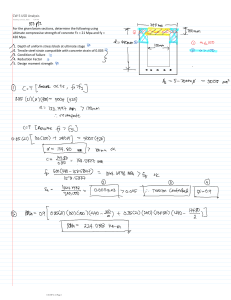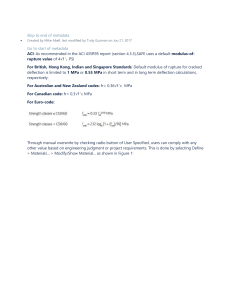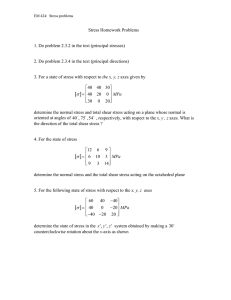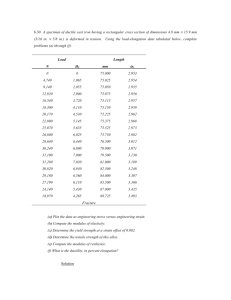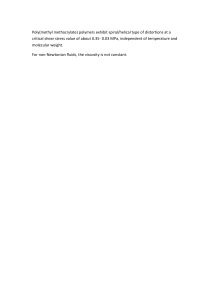Stress-Strain Diagram Examples: Elasticity, Yield, Fracture
advertisement
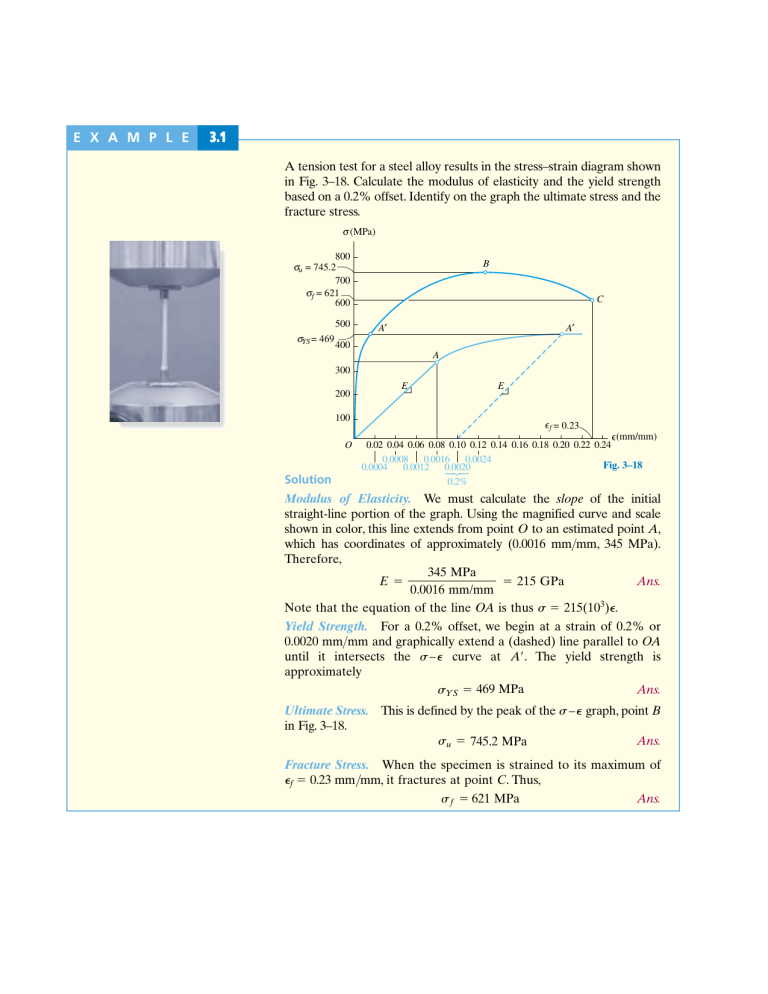
3.1 A tension test for a steel alloy results in the stress–strain diagram shown in Fig. 3–18. Calculate the modulus of elasticity and the yield strength based on a 0.2% offset. Identify on the graph the ultimate stress and the fracture stress. σ (MPa) 800 σu = 745.2 700 σf = 621 600 500 σYS = 469 B C A′ A′ 400 A 300 200 E E 100 Solution (mm/mm) 0.02 0.04 0.06 0.08 0.10 0.12 0.14 0.16 0.18 0.20 0.22 0.24 0.0008 0.0016 0.0024 Fig. 3–18 0.0004 0.0012 0.0020 0.2% O ∋ f = 0.23 ∋ E X A M P L E Modulus of Elasticity. We must calculate the slope of the initial straight-line portion of the graph. Using the magnified curve and scale shown in color, this line extends from point O to an estimated point A, which has coordinates of approximately (0.0016 mm>mm, 345 MPa). Therefore, 345ksi MPa 50 215 3GPa 2 ksi Ans. = 31.2110 E = ——————— 0.0016 in.>in. mm/mm 0.0016 Note that the equation of the line OA is thus 215(103). Yield Strength. For a 0.2% offset, we begin at a strain of 0.2% or 0.0020 mm>mm and graphically extend a (dashed) line parallel to OA until it intersects the s–P curve at A¿. The yield strength is approximately MPa 68 ksi Ans. sYS = 469 Ultimate Stress. This is defined by the peak of the s–P graph, point B in Fig. 3–18. Ans. su = 108 745.2ksiMPa Fracture Stress. When the specimen is strained to its maximum of f 0.23 mm/mm, it fractures at point C. Thus, 90 ksi sf = 621 Ans. MPa E X A M P L E 3.2 The stress–strain diagram for an aluminum alloy that is used for making aircraft parts is shown in Fig. 3–19. If a specimen of this material is stressed to 600 MPa, determine the permanent strain that remains in the specimen when the load is released. Also, compute the modulus of resilience both before and after the load application. Solution Permanent Strain. When the specimen is subjected to the load, it strain-hardens until point B is reached on the s–P diagram, Fig. 3–19. The strain at this point is approximately 0.023 mm>mm. When the σ (MPa) load is released, the material behaves by following the straight line BC, which is parallel to line OA. Since both lines have the same 750 slope, the strain at point C can be determined analytically. The slope of line OA is the modulus of elasticity, i.e., 600 450 MPa E = = 75.0 GPa 0.006 mm>mm A σY = 450 parallel From triangle CBD, we require 300 6 600110 2 Pa BD E = = = 75.011092 Pa CD CD 150 CD = 0.008 mm>mm This strain represents the amount of recovered elastic strain. The permanent strain, POC, is thus POC = 0.023 mm>mm - 0.008 mm>mm = 0.0150 mm>mm Ans. Note: If gauge marks on the specimen were originally 50 mm apart, then after the load is released these marks will be 50 mm + 10.01502 150 mm2 = 50.75 mm apart. Modulus of Resilience. Applying Eq. 3–8, we have* 1 1 1ur2initial = splPpl = 1450 MPa210.006 mm>mm2 2 2 = 1.35 MJ>m3 Ans. 1 1 splPpl = 1600 MPa210.008 mm>mm2 2 2 = 2.40 MJ>m3 Ans. 1ur2final = By comparison, the effect of strain-hardening the material has caused an increase in the modulus of resilience; however, note that the modulus of toughness for the material has decreased since the area under the original curve, OABF, is larger than the area under curve CBF. *Work in the SI system of units is measured in joules, where 1 J = 1 N # m. O B C D 0.01 0.02 0.03 ∋Y = 0.006 0.023 ∋ OC Fig. 3–19 F 0.04 ∋ (mm/mm) E X A M P L E 3.3 An aluminum rod shown in Fig. 3–20a has a circular cross section and is subjected to an axial load of 10 kN. If a portion of the stress–strain diagram for the material is shown in Fig. 3–20b, determine the approximate elongation of the rod when the load is applied. If the load is removed, what is the permanent elongation of the rod? Take Eal = 70 GPa. 20 mm A 15 mm B C 10 kN 10 kN 600 mm 400 mm (a) Fig. 3–20A σ (MPa) 56.6 60 50 σY = 40 F parallel 30 20 G 10 O 0.02 ∋ OG 0.04 ∋ BC = 0.0450 0.06 ∋ rec = 0.000808 0.08 0.10 0.12 ∋ (mm/mm) (b) Fig. 3–20 Solution For the analysis we will neglect the localized deformations at the point of load application and where the rod’s cross-sectional area suddenly changes. (These effects will be discussed in Sections 4.1 and 4.7.) Throughout the midsection of each segment the normal stress and deformation are uniform. In order to study the deformation of the rod, we must obtain the strain. This is done by first calculating the stress, then using the stress–strain diagram to obtain the strain. The normal stress within each segment is 1011032 N P = sAB = = 31.83 MPa A p 10.01 m22 sBC = 1011032 N P = = 56.59 MPa A p 10.0075 m22 From the stress–strain diagram, the material in region AB is strained elastically since sY = 40 MPa 7 31.83 MPa. Using Hooke’s law, PAB = 31.8311062 Pa sAB = = 0.0004547 mm>mm Eal 7011092 Pa The material within region BC is strained plastically, since sY = 40 MPa 6 56.59 MPa. From the graph, for sBC = 56.59 MPa, PBC L 0.045 mm>mm The approximate elongation of the rod is therefore d = ©PL = 0.0004547 1600 mm2 + 0.045 1400 mm2 = 18.3 mm Ans. When the 10-kN load is removed, segment AB of the rod will be restored to its original length. Why? On the other hand, the material in segment BC will recover elastically along line FG, Fig. 3–20b. Since the slope of FG is Eal, the elastic strain recovery is Prec = 56.5911062 Pa sBC = = 0.000808 mm>mm Eal 7011092 Pa The remaining plastic strain in segment BC is then POG = 0.0450 - 0.000808 = 0.0442 mm>mm Therefore, when the load is removed the rod remains elongated by an amount d¿ = POG LBC = 0.0442 1400 mm2 = 17.7 mm Ans. E X A M P L E 3.4 A bar made of A-36 steel has the dimensions shown in Fig. 3–22. If an axial force of P = 80 kN is applied to the bar, determine the change in its length and the change in the dimensions of its cross section after applying the load. The material behaves elastically. P = 80 kN y 50 mm 1.5 m x P = 80 kN 100 mm z Fig. 3–22 Solution The normal stress in the bar is sz = 8011032 N P = = 16.011062 Pa A 10.1 m210.05 m2 From the table on the inside back cover for A-36 steel, Est = 200 GPa, and so the strain in the z direction is Pz = sz Est = 16.011062 Pa 20011092 Pa = 80110-62 mm>mm The axial elongation of the bar is therefore dz = PzLz = [80110-62]11.5 m2 = 120 mm Ans. Using Eq. 3–9, where nst = 0.32 as found from the inside back cover, the contraction strains in both the x and y directions are Px = Py = -nstPz = -0.32[80110-62] = -25.6 mm>m Thus the changes in the dimensions of the cross section are dx = PxLx = -[25.6110-62]10.1 m2 = -2.56 mm dy = PyLy = -[25.6110-62]10.05 m2 = -1.28 mm Ans. Ans. 3.5 E X A M P L E (MPa) 600 u 500 pl = 504 B Solution = 360 400 A 300 A specimen of titanium alloy is tested in torsion and the shear stress–strain diagram is shown in Fig. 3–25a. Determine the shear modulus G, the proportional limit, and the ultimate shear stress. Also, determine the maximum distance d that the top of a block of this material, shown in Fig. 3–25b, could be displaced horizontally if the material behaves elastically when acted upon by a shear force V. What is the magnitude of V necessary to cause this displacement? 200 100 γu = 0.54 O γpl = 0.008 Shear Modulus. This value represents the slope of the straight-line portion OA of the t–g diagram. The coordinates of point A are (0.008 rad, 360 MPa). Thus, 360 52MPa ksi 3 G = = 6500 Ans. 45(10ksi ) MPa γ (rad) 0.008 rad 0.73 The equation of line OA is therefore 45(103), which is Hooke’s law for shear. (a) Fig. 3–25A Proportional Limit. By inspection, the graph ceases to be linear at point A. Thus, 360ksi MPa tpl = 52 Ans. Ultimate Stress. 75 mm 100 mm d 50 mm γ This value represents the maximum shear stress, point B. From the graph, tu = 504 73 ksi Ans. MPa V Maximum Elastic Displacement and Shear Force. Since the maximum elastic shear strain is 0.008 rad, a very small angle, the top of the block in Fig. 3–25b will be displaced horizontally: (b) dd tan10.008 rad2 L 0.008 rad = ——— 250in.mm Fig. 3–25 d = 0.4 0.016 in. mm Ans. The corresponding average shear stress in the block is pl 360 MPa. Thus, the shear force V needed to cause the displacement is tavg = V ; A V V 36052 MPa ksi = ———————— 13 in.2 mm) (75in.214 mm)(100 V = 624 2700kip kN Ans. 3.6 E X A M P L E An aluminum specimen shown in Fig. 3–26 has a diameter of d0 = 25 mm and a gauge length of L0 = 250 mm. If a force of 165 kN elongates the gauge length 1.20 mm, determine the modulus of elasticity. Also, determine by how much the force causes the diameter of the specimen to contract. Take Gal = 26 GPa and sY = 440 MPa. 165 kN Solution Modulus of Elasticity. The average normal stress in the specimen is s = 16511032 N P = = 336.1 MPa A 1p>4210.025 m22 P = L0 d0 and the average normal strain is 1.20 mm d = = 0.00480 mm>mm L 250 mm Since s 6 sY = 440 MPa, the material behaves elastically. The modulus of elasticity is Eal = 336.111062 Pa s = 70.0 GPa = P 0.00480 Ans. Contraction of Diameter. First, we will determine Poisson’s ratio for the material using Eq. 3–11. E G = 211 + n2 26 GPa = 70.0 GPa 211 + n2 n = 0.346 Since Plong = 0.00480 mm>mm, then by Eq. 3–9, n = 0.346 = Plat Plong Plat 0.00480 mm>mm Plat = -0.00166 mm>mm The contraction of the diameter is therefore d¿ = 10.001662125 mm2 = 0.0415 mm Ans. 165 kN Fig. 3–26
